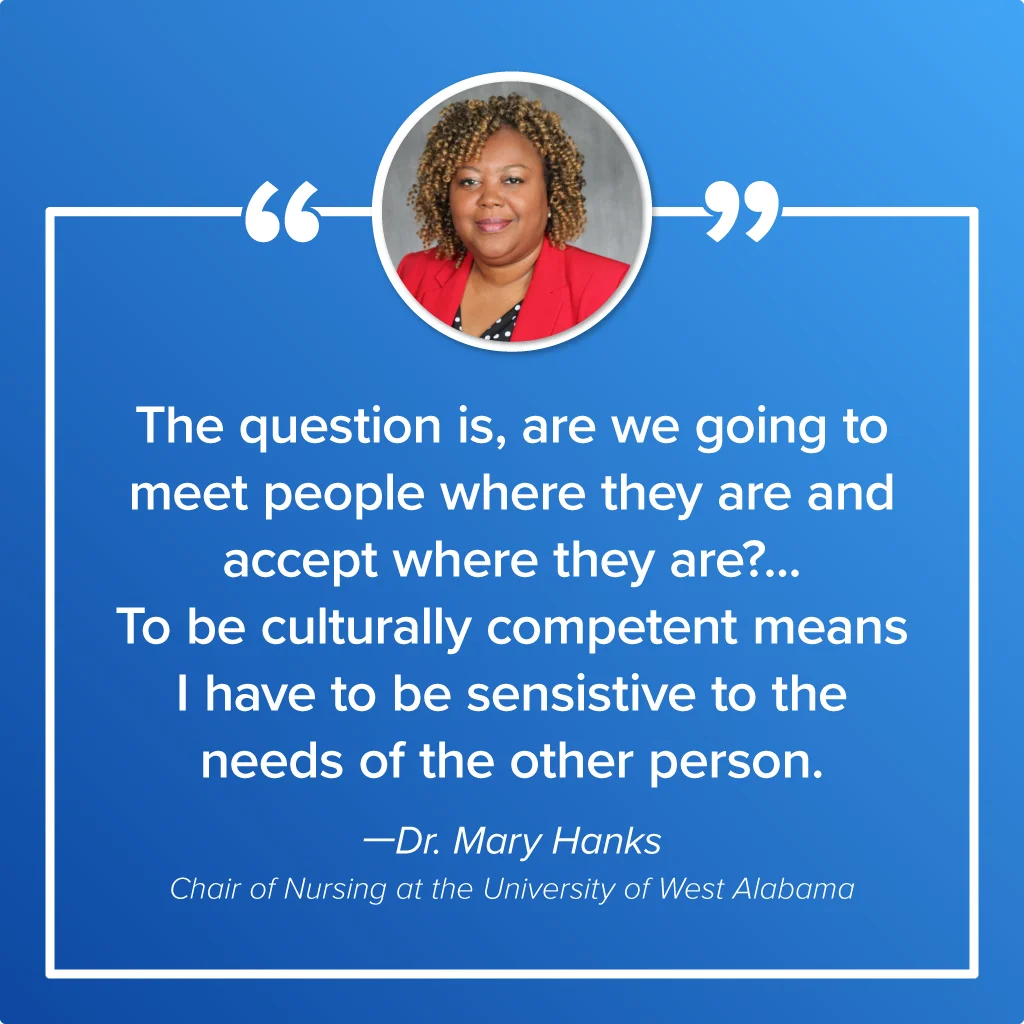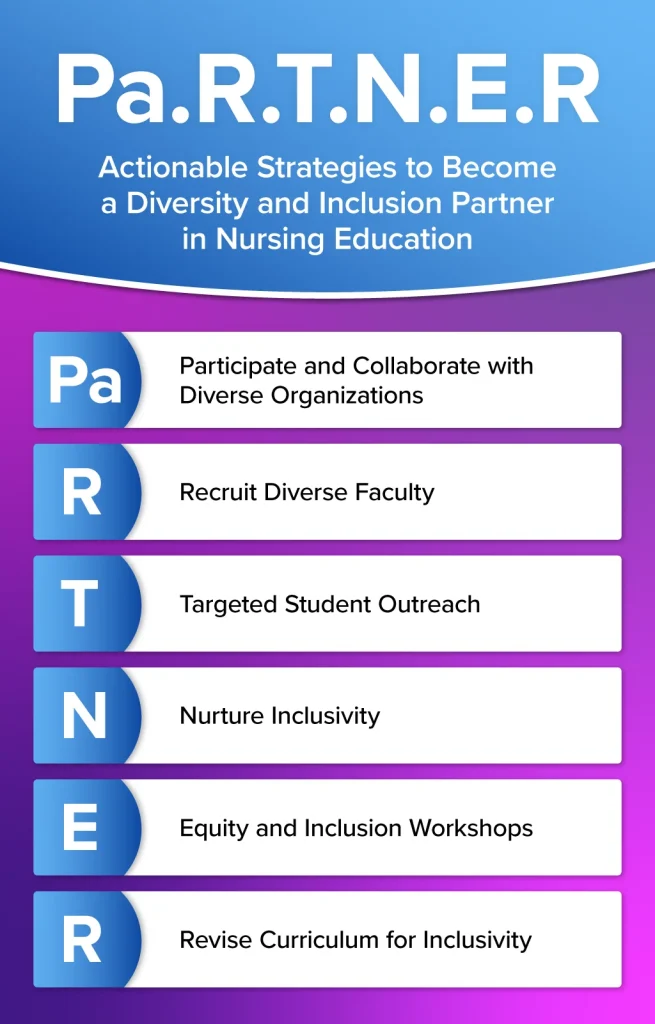The face of America is changing. As patient populations become diverse and projected minority populations become the majority, an inclusive nursing workforce will increasingly be tasked with providing culturally competent care.1
According to the latest data from the National Council of State Boards of Nursing (NCSBN) and the National Forum of State Nursing Workforce Centers, 20% of registered nurses (RNs) and 29% of licensed practical/vocational nurses (LPN/LVNs) are from minority backgrounds.2 These percentages have steadily increased over the past several years, reflecting the growing representation of minority groups in the nursing profession.
| Race/Ethnicity | RN (2008) | RN (2022) | LPN/LVN (2015) | LPN/LVN (2022) |
|---|---|---|---|---|
| Asian | 5.5% | 8.3% | 0.4% | 6.5% |
| Black/African American | 5.4% | 13.4% | 18.5% | 17.6% |
| Hispanic or Latino origin | 3.6% | 7% | 6.4% | 12% |
| American Indian, Alaska Native, Native Hawaiian, or other Pacific Islander | 0.3% | 0.8% | 0.7% | 2.3% |
| White/Caucasian | 83.2% | 80% | 68% | 65.9% |
*Sources2, 3, 4, 5, 6, 7, 8, 9, 10
The diversity of the nursing workforce has seen gradual improvement. In 2008, 5.4% of RNs identified as Black/African American, compared to 13.4% in 2022, representing significant growth in this demographic.11 Similarly, the percentage of Hispanic/Latino RNs increased from 3.6% in 2008 to 7% in 2022.12 While these gains highlight progress, they remain far from aligning with the diverse populations nurses serve, leaving considerable opportunities to further promote representation across all racial and ethnic groups.2
Among minority groups, Hispanic/Latino representation in the LPN workforce has shown particularly rapid growth, from 6.4% in 2015 to 11.5% in 2022.2 This trend is often attributed to targeted recruitment initiatives and increased access to education and career pathways.
At the same time, challenges such as systemic barriers, resource disparities, and limited mentorship opportunities must be addressed to ensure equitable growth across all demographics.
Diversity and Inclusion Challenges in Nursing Education
There are several challenges to achieving diversity in nursing education. A notable one is the recruitment and retention of minority faculty. Underrepresentation among faculty often results in limited diverse perspectives in nursing curricula and fewer mentorship opportunities for underrepresented students, hindering their ability to succeed.
Developing leadership pathways for individuals from underrepresented groups also remains an ongoing barrier, as systemic inequities frequently limit access to resources and opportunities for career advancement. To address the needs of an increasingly multicultural society, nursing education must adapt, ensuring that future healthcare providers are equipped to offer culturally competent care.

Additionally, many students from a variety of economic and cultural backgrounds struggle with the realistic ability to meet traditional nursing school requirements while still managing work and family responsibilities. Dr. Mary Hanks, Chair of Nursing at the University of West Alabama (UWA), faced this critical issue when her students — primarily from economically disadvantaged and minority backgrounds — grappled with balancing home, work, and nursing school responsibilities. Recognizing this, Dr. Hanks emphasized the need for culturally sensitive support and strategies tailored to her students’ individual circumstances.
"The question is, are we going to meet people where they are and accept where they are?” she asked. “To be culturally competent means I have to be sensitive to the needs of the other person."
The Role of Nursing Education in Workforce Diversity
Creating a more diverse nursing workforce begins with expanding access and opportunities within nursing education. But what actionable steps can nurse educators take? By actively recruiting and supporting underrepresented students, as well as revising curriculum and fostering partnerships with minority-serving institutions, nursing programs can drive meaningful change.

Partner with Diverse Organizations
Collaboration with professional associations and organizations can significantly enhance diversity and inclusion efforts in nursing education. Nurse educators and academic programs can work alongside these groups to establish mentorship initiatives, offer targeted support to underrepresented students, and promote inclusive practices. By leveraging the resources and networks of organizations such as the National Black Nurses Association and the National Association of Hispanic Nurses, you can provide your students with meaningful opportunities that strengthen diverse student recruitment and retention.
Pa.R.T.N.E.R.ing in Action:
- Partner with historically Black colleges and universities (HBCUs), Hispanic-serving institutions, and other minority-serving colleges to create pathways for diverse students into nursing programs.
- Collaborate with diverse high schools, community colleges, and pre-nursing programs to develop targeted recruitment efforts and summer bridge programs for underrepresented students.
- Establish formal mentoring initiatives for underrepresented students and faculty by partnering with professional nursing organizations and healthcare facilities.
Recruit Diverse Faculty
Expanding hiring efforts to attract underrepresented nursing faculty requires a multifaceted approach that emphasizes diversity at every level of recruitment. Academic nursing programs can promote diverse faculty hiring by including voices from varied backgrounds on leadership committees and rethinking traditional recruitment practices. This includes implementing strategies such as targeted outreach to minority communities, attending diversity-focused job fairs, and crafting inclusive job postings that highlight a commitment to diversity, equity, and inclusion.
Pa.R.T.N.E.R.ing in Action:
- Establish diverse committees that enable nurses from all settings and roles to actively participate in decision-making and leadership development activities.
- Develop recruitment strategies targeting diverse candidates, such as partnering with community organizations and attending specific job fairs.
- Use inclusive language in job postings, avoiding discriminatory terms and clearly communicating the institution’s dedication to diversity, equity, and inclusion (DEI).
Targeted Student Outreach
To eliminate barriers and engage underrepresented students, adopt strategies that focus on creating equitable opportunities in your nursing program. This includes supporting students through academic resources, offering scholarships and tuition discounts, and establishing pipeline programs that guide students from high school through nursing education. Additionally, embracing holistic admissions processes allows for a more inclusive evaluation of applicants, considering unique experiences, community contributions, and diverse backgrounds alongside traditional academic metrics.
Pa.R.T.N.E.R.ing in Action:
- Implement a holistic review that evaluates an applicant's unique experiences alongside academic measures, incorporating factors such as community service, personal attributes, and diverse life experiences.
- Provide academic and financial resources by creating scholarships specifically for diverse candidates and pursuing funding to offer tuition assistance for underrepresented groups.
- Partner with minority-serving institutions, such as historically Black colleges and universities (HBCUs) and Hispanic-serving institutions, and collaborate with high schools, community colleges, and pre-nursing programs to establish targeted recruitment efforts and summer bridge programs.
Nurture Inclusivity
Building a supportive learning environment requires intentionality and empathy. Nurse educators can foster inclusivity by creating welcoming classrooms where all students feel respected and valued. Simple strategies, such as learning students' names and acknowledging diverse perspectives, help create a sense of belonging that supports academic success and engagement.
Pa.R.T.N.E.R.ing in Action:
- Establish classroom norms that encourage respect and open communication, creating an inclusive space where students feel safe expressing their ideas and perspectives.
- Inspire underrepresented students by integrating stories of diverse nursing pioneers into the curriculum, showcasing trailblazers who overcame challenges and achieved success.
- Normalize seeking help by promoting academic and wellness resources, destigmatizing their use, and fostering a supportive environment for students to thrive.
Equity and Inclusion Workshops
Providing training opportunities for educators will foster equity and inclusion within your school’s nursing program. Workshops and seminars, such as those offered at the National Conference on Race and Ethnicity in American Higher Education, can help nurse educators address implicit biases and build cultural humility. By integrating reflection opportunities and evidence-based strategies, these initiatives enhance cultural competence and promote inclusive practices among faculty and staff.
Pa.R.T.N.E.R.ing in Action:
- Offer workshops that introduce implicit bias, teach recognition and management of biases, and provide actionable tools for behavior change while encouraging self-reflection to cultivate cultural humility.
- Develop courses on cultural competence, minority health, and racial healthcare disparities to increase faculty awareness and knowledge of diversity-related issues.
- Incorporate tools such as the Implicit Association Test (IAT) into faculty training programs to support reductions in implicit bias and promote more inclusive teaching practices.
Revise Curriculum for Inclusivity
Address health disparities and teach culturally appropriate care by incorporating DEI concepts directly into your nursing program’s curriculum. This can include the use of diverse case studies to represent varied patient backgrounds and applying virtual simulation tools that allow students to navigate complex, realistic scenarios involving culturally sensitive care. These strategies provide practical, immersive learning experiences that enhance students’ ability to deliver equitable care.
Pa.R.T.N.E.R.ing in Action:
- Incorporate lessons on DEI concepts, implicit bias, and microaggressions into nursing courses. Review current course materials and test items for bias, and ensure images represent a diverse population.
- Leverage UWorld’s NGN case studies featuring patients from diverse cultural backgrounds, enabling students to practice culturally sensitive care in controlled environments.
- Utilize virtual simulation platforms to create immersive learning experiences with diverse patient scenarios, helping students refine clinical reasoning and decision-making skills.
Leading by Example
Nurse educators hold a pivotal role in fostering diversity and inclusion in their programs by leading through action and example. By actively engaging with students from diverse backgrounds, you can demonstrate respect for cultural differences and incorporate varied perspectives into your nursing program’s curriculum. This approach enriches the learning experience for all students and creates an environment where every individual feels respected and valued, regardless of their cultural or ethnic background. By modeling inclusive behavior and encouraging cross-cultural communication, you’ll set a standard that students can emulate in their future professional practice.
Mentorship is a powerful way nurse educators can lead by example. By providing guidance, advocacy, and support to underrepresented students, you can help them overcome the unique challenges they may face in their educational journey. These mentorship efforts are vital for retaining a diverse student body and equipping them with the confidence and skills needed to succeed in the nursing profession.
Prioritizing Diversity and Inclusion in Nursing Education
Nurse educators play a crucial role in shaping the next generation of nurses by creating learning environments that prioritize diversity and inclusion. By fostering classrooms that value empathy, respect, and cultural understanding, you can prepare future nurses to deliver compassionate, patient-centered care to individuals from all backgrounds. This commitment reinforces the art of nursing — the human connection that profoundly impacts patients’ lives.
References
- Collage Group. (2024, January 17). Multicultural Americans to become majority population by 2050: Report. The Hill. Retrieved from https://thehill.com/homenews/4412311-multicultural-americans-majority-population-2050/
- Smiley, R. A., Allgeyer, R. L., Shobo, Y., Zhong, E., Kaminski-Ozturk, N., & Alexander, M. (2023). The 2022 national nursing workforce survey. Journal of Nursing Regulation, 14(2). https://doi.org/10.1016/S2155-8256(23)00047-9
- PMC. (n.d.). Health equity articles archive. Retrieved from https://pmc.ncbi.nlm.nih.gov/articles/PMC3863700/
- PMC. (n.d.). Nursing workforce diversity study. Retrieved from https://pmc.ncbi.nlm.nih.gov/articles/PMC4799908/
- Health Resources and Services Administration (HRSA). (n.d.). HRSA study finds nursing workforce is growing and more diverse. PR Newswire. Retrieved from https://www.prnewswire.com/news-releases/hrsa-study-finds-nursing-workforce-is-growing-and-more-diverse-88220442.html
- U.S. Department of Health and Human Services. (2015). 2015 LPN license renewal report. Campaign for Action. Retrieved from https://campaignforaction.org/wp-content/uploads/2023/03/2015-LPN-License-Renewal-Report.pdf
- National Council of State Boards of Nursing (NCSBN). (2017). The 2017 national nursing workforce survey. Retrieved from https://www.ncsbn.org/public-files/2017NNWS.pdf
- U.S. Department of Health and Human Services. (2015). 2015 LPN license renewal report. Campaign for Action. Retrieved from https://campaignforaction.org/wp-content/uploads/2023/03/2015-LPN-License-Renewal-Report.pdf
- National Council of State Boards of Nursing (NCSBN). (2017). The 2017 national nursing workforce survey. Retrieved from https://www.ncsbn.org/public-files/2017NNWS.pdf
- Zippia. (n.d.). Licensed practical nurse demographics. Retrieved from https://www.zippia.com/licensed-practical-nurse-jobs/demographics/
- PMC. (n.d.). Health equity articles archive. Retrieved from https://pmc.ncbi.nlm.nih.gov/articles/PMC3863700/
- PMC. (n.d.). Nursing workforce diversity study. Retrieved from https://pmc.ncbi.nlm.nih.gov/articles/PMC4799908/
- NurseJournal. (n.d.). Diversity, equity, and inclusion in nursing education. Retrieved from https://nursejournal.org/articles/dei-in-nursing-education/
- American Nurses Association. (n.d.). Promote diversity in nursing. Retrieved from https://www.nursingworld.org/content-hub/resources/workplace/promote-diversity-in-nursing/
- NurseJournal. (n.d.). What are schools doing to increase diversity in nursing? Retrieved from https://nursejournal.org/articles/what-are-schools-doing-to-increase-diversity-in-nursing/
- Kaplan Test Prep. (n.d.). Diversity, equity, and inclusion in nursing: Strategies for educators. Retrieved from https://www.kaptest.com/blogs/nursing-educators/post/diversity-equity-inclusion-nursing-strategies









